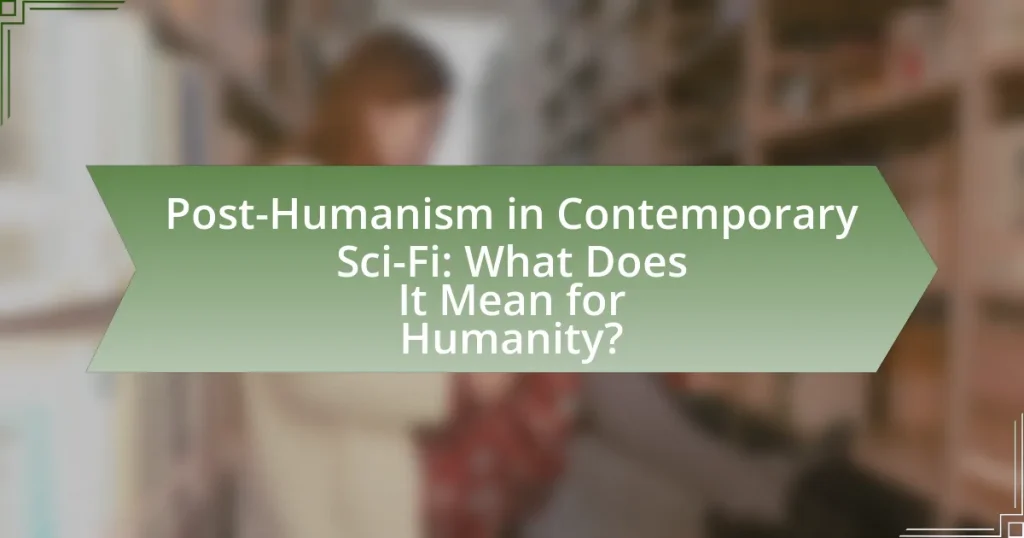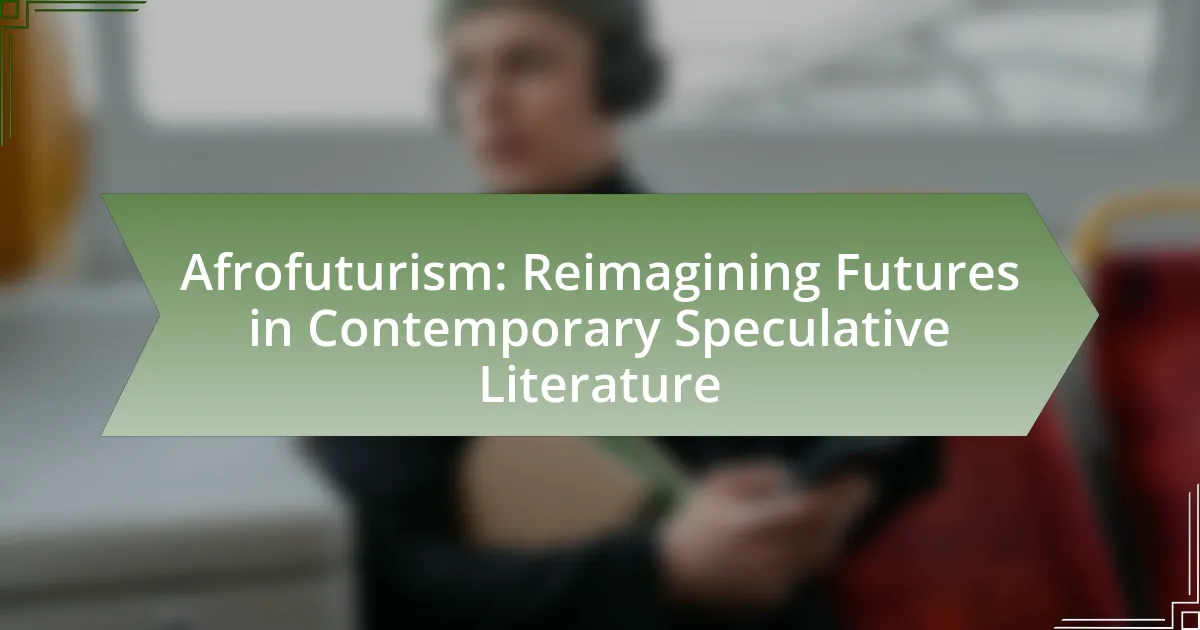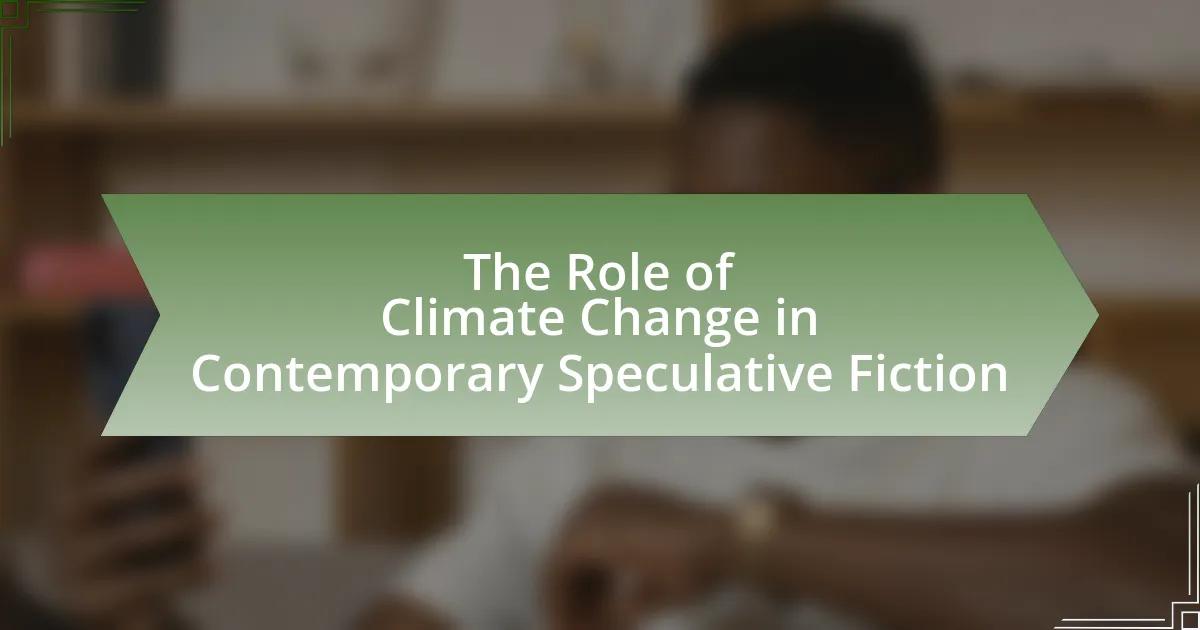Post-Humanism in contemporary sci-fi is a philosophical and literary movement that examines the implications of transcending human limitations through technology, genetic engineering, and artificial intelligence. The article explores how Post-Humanism redefines humanity, challenges traditional humanist values, and presents ethical dilemmas arising from technological advancements. It highlights key characteristics of Post-Humanist narratives, including the integration of technology with human identity and the portrayal of artificial intelligences as sentient beings. Additionally, the article discusses notable works in the genre, their societal reflections, and the potential future scenarios they suggest for humanity, emphasizing the need for ethical considerations in the face of rapid technological change.
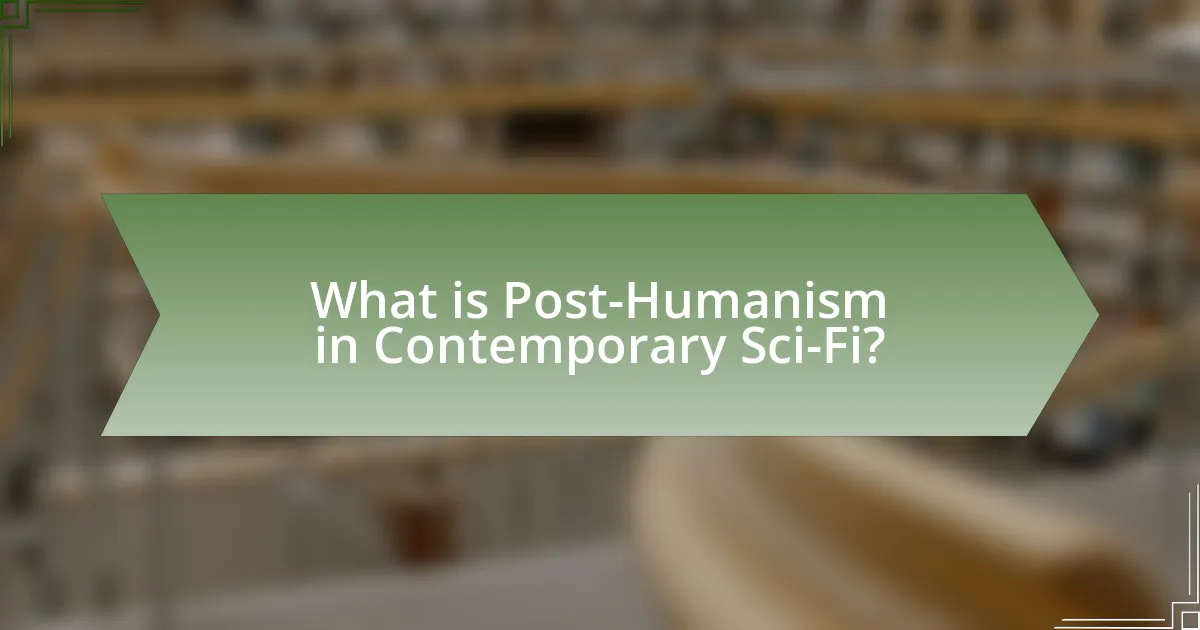
What is Post-Humanism in Contemporary Sci-Fi?
Post-Humanism in contemporary sci-fi refers to a philosophical and literary movement that explores the implications of transcending traditional human limitations through technology, genetic engineering, and artificial intelligence. This genre often depicts scenarios where humans evolve into post-human entities, challenging the notion of what it means to be human. Works such as “Neuromancer” by William Gibson and “Altered Carbon” by Richard K. Morgan illustrate these themes by presenting characters who augment their physical and cognitive abilities, raising questions about identity, morality, and the future of humanity.
How does Post-Humanism redefine the concept of humanity?
Post-Humanism redefines the concept of humanity by challenging the traditional boundaries of what it means to be human, emphasizing the integration of technology, biology, and consciousness. This philosophical framework posits that humanity is not a fixed essence but a dynamic construct influenced by advancements in artificial intelligence, genetic engineering, and cybernetics. For instance, the emergence of cyborgs and AI entities illustrates how Post-Humanism blurs the lines between human and machine, suggesting that identity and agency can extend beyond biological limitations. This perspective is supported by theorists like N. Katherine Hayles, who argues that the post-human condition reflects a shift towards a more inclusive understanding of intelligence and existence, thereby expanding the definition of humanity to encompass a broader spectrum of beings and experiences.
What philosophical underpinnings support Post-Humanism in Sci-Fi?
Post-Humanism in Sci-Fi is supported by philosophical underpinnings such as anti-humanism, transhumanism, and speculative realism. Anti-humanism critiques the centrality of human experience and emphasizes the interconnectedness of all entities, suggesting that human identity is not fixed but fluid. Transhumanism advocates for the enhancement of the human condition through technology, proposing that humanity can evolve beyond its current limitations. Speculative realism challenges anthropocentrism, positing that reality exists independently of human perception, thus allowing for a broader understanding of existence beyond human-centric narratives. These philosophies collectively inform Sci-Fi narratives that explore the implications of technology, identity, and existence in a post-human context.
How do different Sci-Fi narratives portray Post-Humanist themes?
Different Sci-Fi narratives portray Post-Humanist themes by exploring the transformation of humanity through technology, artificial intelligence, and genetic modification. For instance, in works like “Neuromancer” by William Gibson, the integration of human consciousness with cyberspace illustrates the blurring of boundaries between human and machine, emphasizing a future where identity is fluid and constructed. Similarly, “The Matrix” presents a reality where human perception is manipulated by artificial constructs, raising questions about autonomy and existence. These narratives often depict characters who transcend traditional human limitations, reflecting Post-Humanist ideas that challenge the notion of a fixed human essence. The portrayal of enhanced beings or AI as sentient entities further complicates ethical considerations regarding personhood and rights, as seen in “Blade Runner,” where replicants seek recognition and agency. Overall, these narratives serve as a lens to examine the implications of evolving human conditions in a technologically advanced society.
What are the key characteristics of Post-Humanism in Sci-Fi?
Post-Humanism in Sci-Fi is characterized by the exploration of human enhancement, the blurring of boundaries between human and machine, and the questioning of traditional notions of identity and consciousness. These characteristics manifest through narratives that depict advanced technologies, such as artificial intelligence and genetic engineering, which challenge the limitations of the human condition. For instance, works like “Neuromancer” by William Gibson illustrate the integration of human consciousness with digital environments, emphasizing the fluidity of identity. Additionally, post-humanist themes often critique anthropocentrism, suggesting a shift towards a more inclusive understanding of existence that encompasses non-human entities. This is evident in texts like “The Windup Girl” by Paolo Bacigalupi, where ecological and technological factors redefine what it means to be human.
How does technology influence the evolution of human identity in these narratives?
Technology profoundly influences the evolution of human identity in narratives by reshaping perceptions of self and society. In contemporary sci-fi, advancements such as artificial intelligence, genetic engineering, and virtual reality challenge traditional notions of what it means to be human. For instance, characters often grapple with the implications of merging human consciousness with machines, leading to questions about autonomy and individuality. This is evident in works like “Neuromancer” by William Gibson, where the integration of technology creates new identities that blur the lines between human and machine. Such narratives illustrate how technology not only alters physical capabilities but also redefines emotional and social connections, ultimately transforming the essence of human identity.
What role do artificial intelligences play in Post-Humanist stories?
Artificial intelligences in Post-Humanist stories often serve as catalysts for exploring the boundaries of human identity and consciousness. These narratives frequently depict AIs as entities that challenge traditional notions of humanity, prompting characters and readers to reconsider what it means to be human. For instance, in works like “Neuromancer” by William Gibson, AI characters such as Wintermute and Neuromancer illustrate the potential for intelligence beyond human capabilities, raising questions about autonomy, morality, and the essence of self. This thematic exploration is supported by the increasing integration of technology in daily life, reflecting contemporary anxieties and aspirations regarding human evolution and the role of machines in shaping future societies.
Why is Post-Humanism significant in contemporary discussions about humanity?
Post-Humanism is significant in contemporary discussions about humanity because it challenges traditional notions of what it means to be human, particularly in the context of technological advancements and ethical considerations. This philosophical framework encourages a reevaluation of human identity, agency, and the relationship between humans and non-human entities, including artificial intelligence and biotechnology. For instance, the rise of AI and genetic engineering prompts critical questions about autonomy, consciousness, and moral responsibility, which are central to post-humanist discourse. By addressing these issues, post-humanism fosters a deeper understanding of the implications of emerging technologies on society and individual identity, making it a crucial topic in current debates about the future of humanity.
How does Post-Humanism challenge traditional humanist values?
Post-Humanism challenges traditional humanist values by questioning the centrality of the human experience and the notion of human exceptionalism. Traditional humanism emphasizes human rationality, individuality, and moral agency, often placing humans at the pinnacle of existence. In contrast, Post-Humanism advocates for a more inclusive understanding of intelligence and agency that encompasses non-human entities, such as animals, machines, and ecosystems. This shift is evident in the works of theorists like N. Katherine Hayles, who argues that the boundaries between human and non-human are increasingly blurred in a technologically advanced society. By promoting a decentered view of humanity, Post-Humanism critiques the anthropocentric perspective that has historically dominated humanist thought.
What implications does Post-Humanism have for future societal structures?
Post-Humanism suggests that future societal structures will increasingly integrate technology and biology, leading to a redefinition of what it means to be human. This integration may result in enhanced cognitive and physical abilities, altering social hierarchies and power dynamics. For instance, advancements in biotechnology and artificial intelligence could create a divide between those who can afford enhancements and those who cannot, potentially leading to new forms of inequality. Additionally, Post-Humanism challenges traditional concepts of identity and community, as individuals may form connections based on shared technological experiences rather than biological or cultural ties. This shift could foster more fluid social structures, emphasizing collaboration and interconnectedness over individualism.
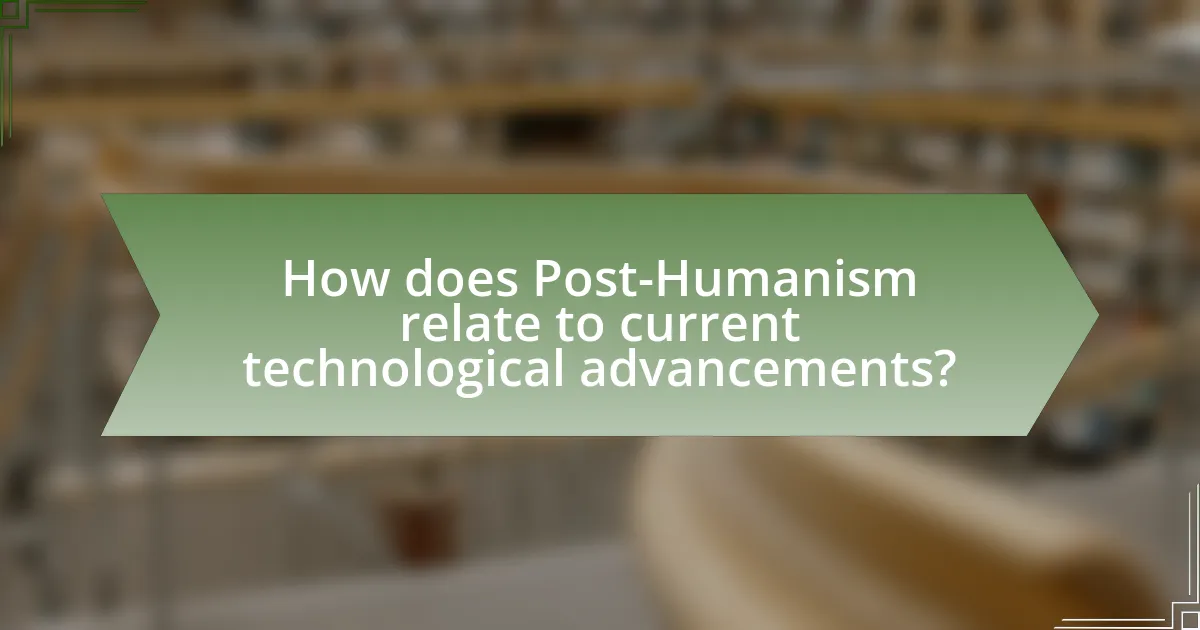
How does Post-Humanism relate to current technological advancements?
Post-Humanism is intrinsically linked to current technological advancements as it challenges traditional notions of humanity and explores the implications of integrating technology into human life. This philosophical framework posits that advancements such as artificial intelligence, biotechnology, and cybernetics can redefine human capabilities and existence. For instance, the rise of AI technologies, which can enhance cognitive functions and automate tasks, exemplifies Post-Humanist ideas by blurring the lines between human and machine intelligence. Furthermore, developments in genetic engineering, such as CRISPR, raise ethical questions about the modification of human traits, aligning with Post-Humanist themes of transcending biological limitations. These advancements illustrate how Post-Humanism not only critiques but also embraces the transformative potential of technology in shaping future human experiences.
What technologies are often depicted in Post-Humanist Sci-Fi?
Post-Humanist Sci-Fi often depicts advanced technologies such as artificial intelligence, biotechnology, cybernetics, and virtual reality. These technologies explore themes of human enhancement, consciousness transfer, and the merging of human and machine. For instance, artificial intelligence is frequently portrayed as sentient beings that challenge the notion of what it means to be human, while biotechnology raises ethical questions about genetic modification and life extension. Cybernetics illustrates the integration of technology with the human body, exemplified by characters with augmented abilities. Virtual reality creates immersive experiences that blur the lines between reality and simulation, prompting reflections on identity and existence. These depictions serve to question the future of humanity in an increasingly technological world.
How do these technologies alter human capabilities and experiences?
Technologies alter human capabilities and experiences by enhancing cognitive functions, physical abilities, and emotional interactions. For instance, advancements in artificial intelligence enable individuals to process information more efficiently, leading to improved decision-making and problem-solving skills. Additionally, wearable devices and biotechnology can augment physical performance, allowing for greater endurance and strength. Furthermore, virtual reality and augmented reality technologies transform social interactions by creating immersive environments that facilitate new forms of communication and connection. These changes are evidenced by studies showing that users of cognitive enhancement tools report increased productivity and satisfaction, while those engaging with immersive technologies experience heightened empathy and understanding in social contexts.
What ethical dilemmas arise from these technological advancements?
Technological advancements in post-humanism raise significant ethical dilemmas, primarily concerning autonomy, privacy, and the definition of humanity. These advancements, such as artificial intelligence and genetic engineering, challenge the notion of individual autonomy by enabling external control over personal choices and behaviors. For instance, AI systems can manipulate decision-making processes, potentially undermining free will. Additionally, privacy concerns arise as technologies collect vast amounts of personal data, leading to surveillance and loss of confidentiality. The definition of humanity itself is also questioned, as enhancements blur the lines between human and machine, raising moral issues about the rights of augmented individuals versus non-augmented ones. These dilemmas necessitate careful consideration of ethical frameworks to navigate the implications of such advancements on society.
How do contemporary authors approach Post-Humanism in their works?
Contemporary authors approach Post-Humanism by exploring the implications of technology on human identity and existence. They often depict scenarios where human and non-human entities coexist, challenging traditional notions of humanity. For instance, authors like Octavia Butler and Ted Chiang examine themes of genetic modification and artificial intelligence, illustrating how these advancements redefine what it means to be human. Their narratives frequently highlight ethical dilemmas and the potential for both enhancement and alienation, reflecting societal anxieties about the future of human evolution in a technologically driven world.
What are some notable examples of Post-Humanist literature and films?
Notable examples of Post-Humanist literature include “Neuromancer” by William Gibson, which explores the integration of technology and human consciousness, and “The Windup Girl” by Paolo Bacigalupi, which examines genetic engineering and its implications for humanity. In film, “Blade Runner” directed by Ridley Scott presents a future where artificial beings challenge the definition of humanity, while “Ex Machina,” directed by Alex Garland, delves into artificial intelligence and ethical considerations surrounding sentience. These works illustrate the themes of identity, technology, and the evolving nature of humanity in a post-humanist context.
How do these works reflect societal fears and hopes regarding the future?
Contemporary sci-fi works reflect societal fears and hopes regarding the future by exploring themes of technological advancement, identity, and existential risk. These narratives often depict dystopian scenarios where unchecked technology leads to societal collapse, illustrating fears about loss of control and ethical dilemmas, as seen in works like “Black Mirror,” which critiques the implications of digital technology on human relationships. Conversely, they also present optimistic visions of a future where technology enhances human capabilities and fosters global unity, as exemplified in “The Expanse,” which portrays cooperation among diverse factions to address existential threats. This duality in representation underscores the complex relationship society has with progress, highlighting both the potential for innovation and the risks of dehumanization.
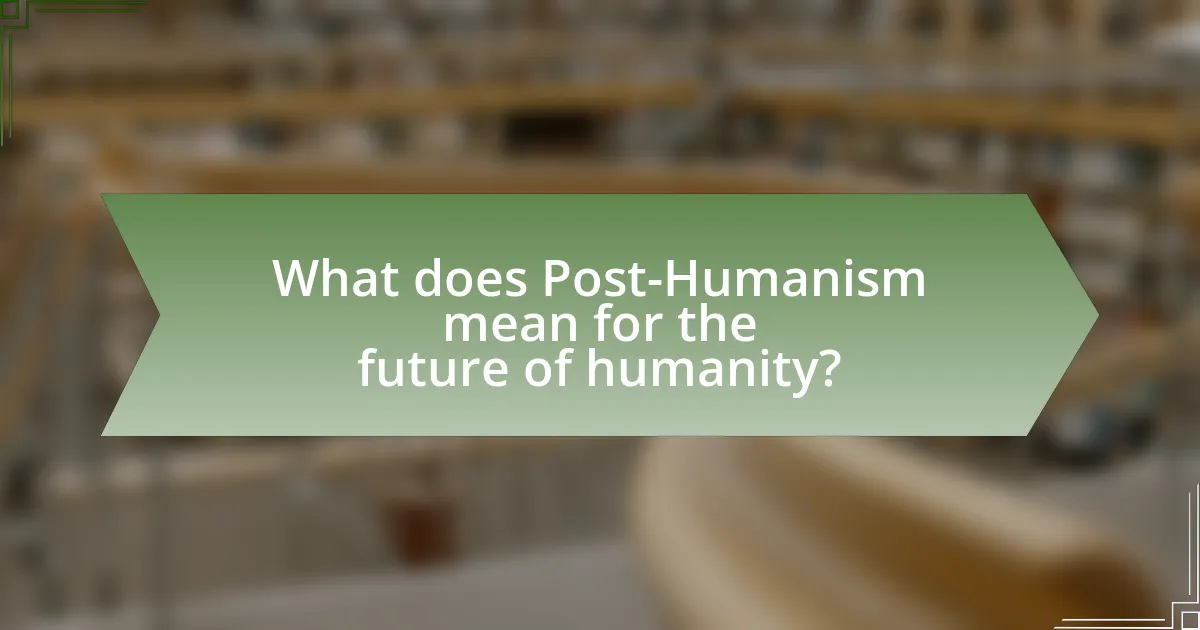
What does Post-Humanism mean for the future of humanity?
Post-Humanism suggests a transformative future for humanity characterized by the integration of technology and biology, leading to enhanced cognitive and physical capabilities. This philosophical framework posits that advancements in artificial intelligence, biotechnology, and cybernetics will redefine human existence, potentially resulting in a post-biological state where traditional human limitations are transcended. For instance, the development of neural interfaces and genetic engineering could enable individuals to augment their intelligence and lifespan, fundamentally altering societal structures and ethical considerations. The implications of Post-Humanism are profound, as they challenge existing notions of identity, agency, and what it means to be human in an increasingly technologically mediated world.
How might Post-Humanism influence future human evolution?
Post-Humanism may influence future human evolution by promoting the integration of technology with biological systems, leading to enhanced cognitive and physical capabilities. This philosophical framework encourages the exploration of transhumanist ideals, where advancements in genetic engineering, artificial intelligence, and cybernetics could redefine human limitations. For instance, the development of CRISPR technology allows for precise genetic modifications, potentially eradicating hereditary diseases and enhancing human traits. Additionally, the rise of brain-computer interfaces, as seen in projects like Neuralink, could augment human intelligence and connectivity, fundamentally altering the evolutionary trajectory of humanity.
What potential scenarios do Sci-Fi narratives suggest for humanity’s future?
Sci-Fi narratives suggest several potential scenarios for humanity’s future, including dystopian societies, utopian advancements, and the emergence of post-human entities. Dystopian scenarios often depict a future where technology exacerbates social inequalities, environmental degradation, or authoritarian control, as seen in works like “1984” by George Orwell and “The Hunger Games” by Suzanne Collins. Utopian visions, on the other hand, present possibilities for harmonious coexistence through technological advancements, such as in “Star Trek,” where humanity has overcome many social issues. Additionally, narratives exploring post-humanism, like “Ghost in the Shell,” suggest that humanity may evolve into or merge with advanced technologies, leading to new forms of consciousness and existence. These scenarios reflect ongoing concerns and aspirations regarding technology’s impact on society and the human condition.
How can we prepare for the changes proposed by Post-Humanist thought?
To prepare for the changes proposed by Post-Humanist thought, individuals and societies should engage in interdisciplinary education that encompasses philosophy, technology, and ethics. This approach fosters critical thinking about the implications of emerging technologies, such as artificial intelligence and biotechnology, which are central to Post-Humanist discourse. For instance, understanding the ethical considerations surrounding genetic modification can help guide responsible innovation. Additionally, promoting public discourse on the societal impacts of these technologies can enhance collective awareness and readiness for potential shifts in human identity and agency.
What practical insights can we draw from Post-Humanism in Sci-Fi?
Post-Humanism in Sci-Fi offers practical insights into the evolving relationship between humanity and technology, emphasizing the potential for enhanced human capabilities and ethical considerations. For instance, narratives often explore themes of identity, agency, and the implications of artificial intelligence, prompting critical discussions about what it means to be human in a technologically advanced society. Works like “Neuromancer” by William Gibson illustrate the merging of human consciousness with machines, highlighting both the benefits of cognitive enhancement and the risks of losing individuality. These insights encourage reflection on current technological advancements, such as AI and biotechnology, urging society to consider ethical frameworks that govern their integration into daily life.
How can understanding Post-Humanism inform our approach to technology today?
Understanding Post-Humanism can inform our approach to technology today by encouraging a critical examination of the relationship between humans and technology, emphasizing the need for ethical considerations in technological advancements. Post-Humanism challenges traditional human-centric views, suggesting that technology should not merely serve human interests but also consider the implications for non-human entities and the environment. This perspective is supported by the increasing integration of artificial intelligence and biotechnology into daily life, which raises questions about agency, identity, and the definition of what it means to be human. For instance, the rise of AI technologies necessitates discussions about autonomy and the potential for machines to influence human decision-making, as highlighted in the works of theorists like N. Katherine Hayles, who argues that understanding the post-human condition is essential for navigating the complexities of contemporary technological landscapes.
What lessons can we learn from Post-Humanist narratives about our current trajectory?
Post-Humanist narratives teach us that our current trajectory must prioritize ethical considerations in technology and the environment. These narratives often explore the consequences of unchecked technological advancement, emphasizing the need for a balanced relationship between humanity and non-human entities. For instance, works like “Neuromancer” by William Gibson illustrate the potential dangers of artificial intelligence and corporate control, prompting discussions about the ethical implications of such technologies. Additionally, Post-Humanism encourages a re-evaluation of human exceptionalism, advocating for a more inclusive understanding of agency that encompasses both human and non-human actors. This perspective is crucial as we navigate challenges like climate change and biodiversity loss, highlighting the interconnectedness of all life forms and the responsibility we hold towards them.
